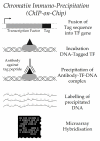DNA microarrays: a powerful genomic tool for biomedical and clinical research
- PMID: 17660860
- PMCID: PMC1933257
- DOI: 10.2119/2006-00107.Trevino
DNA microarrays: a powerful genomic tool for biomedical and clinical research
Abstract
Among the many benefits of the Human Genome Project are new and powerful tools such as the genome-wide hybridization devices referred to as microarrays. Initially designed to measure gene transcriptional levels, microarray technologies are now used for comparing other genome features among individuals and their tissues and cells. Results provide valuable information on disease subcategories, disease prognosis, and treatment outcome. Likewise, they reveal differences in genetic makeup, regulatory mechanisms, and subtle variations and move us closer to the era of personalized medicine. To understand this powerful tool, its versatility, and how dramatically it is changing the molecular approach to biomedical and clinical research, this review describes the technology, its applications, a didactic step-by-step review of a typical microarray protocol, and a real experiment. Finally, it calls the attention of the medical community to the importance of integrating multidisciplinary teams to take advantage of this technology and its expanding applications that, in a slide, reveals our genetic inheritance and destiny.
Figures













References
-
- Golub TR, Slonim DK, Tamayo P, et al. Molecular classification of cancer: Class discovery and class prediction by gene expression monitoring. Science. 1999;286:531–537. - PubMed
-
- van’t Veer LJ, Dai HY, van de Vijver MJ, et al. Gene expression profiling predicts clinical outcome of breast cancer. Nature. 2002;415:530–536. - PubMed
-
- Singh D, Febbo PG, Ross K, et al. Gene expression correlates of clinical prostate cancer behavior. Cancer Cell. 2002;1:203–209. - PubMed
-
- Wang T, Hopkins D, Schmidt C, et al. Identification of genes differentially over-expressed in lung squamous cell carcinoma using combination of cDNA subtraction and microarray analysis. Oncogene. 2000;19:1519–1528. - PubMed
Publication types
MeSH terms
Substances
LinkOut - more resources
Full Text Sources
Other Literature Sources
